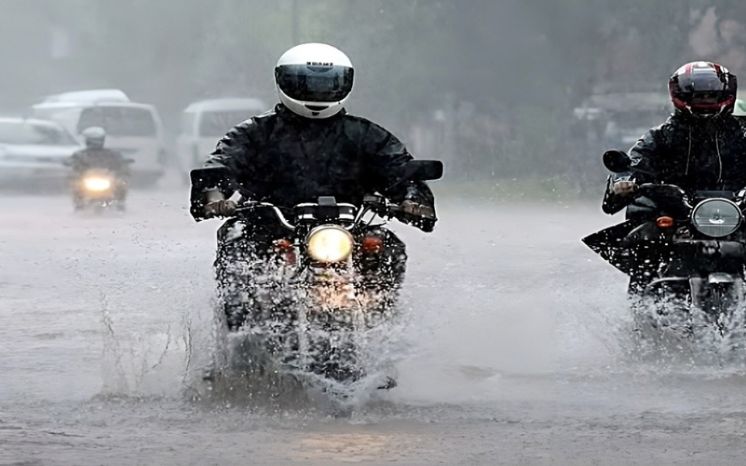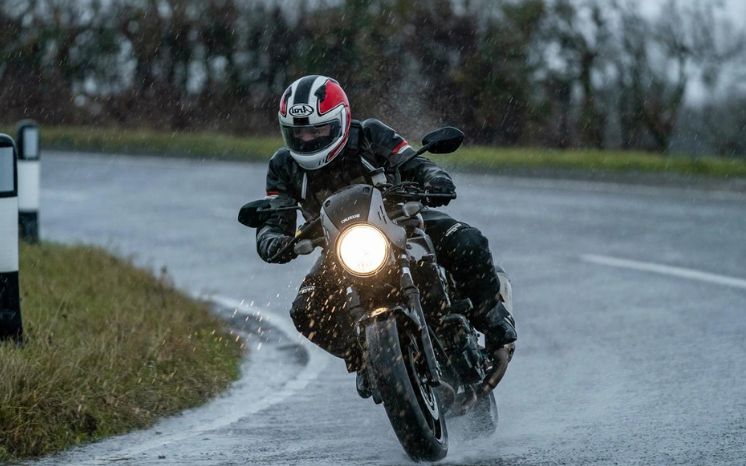Motorcycles, like any other vehicles, are designed to withstand various weather conditions. The question that often arises among new riders or those considering to own a motorbike is, “Can a motorcycle get wet?”
This query comes with valid concerns, considering the exposure of many components on a motorcycle. Understanding how rain or moisture interacts with your ride is crucial for its long-term maintenance and your safety. Let’s dive into this topic and provide some clarity.
Can A Motorcycle Get Wet?
Yes, a motorcycle can get wet. However, the extent to which it can handle water depends on several factors such as the type of bike, its condition, and the duration and intensity of exposure. Generally, motorcycles are designed to withstand light rain and moisture. However, prolonged or heavy exposure to water can lead to problems that may affect the performance of your ride.
Types of Motorcycles
There are different types of motorcycles, and each has its unique design and components. Some are built for off-road adventures with larger tires and higher ground clearance, while others are designed for speed on paved roads with sleeker bodies. These variations impact how well a motorcycle can handle water.
Off-road bikes, also known as dirt bikes, usually have more robust and higher-placed components to prevent water from damaging vital parts such as the engine. On the other hand, street bikes have more exposed components that are vulnerable to water damage.
Condition of the Motorcycle
The condition of your motorcycle also plays a crucial role in how well it can handle rain or moisture. Regular maintenance is essential for any vehicle, and this applies even more so for motorcycles. Over time, seals and gaskets may wear out or become loose, allowing water to seep into areas that it shouldn’t.
It’s important to inspect your motorcycle before each ride and address any maintenance issues promptly to prevent water damage. This includes checking the tire treads, brake pads, and ensuring all seals and gaskets are intact.
Duration and Intensity of Exposure
As mentioned earlier, motorcycles are designed to withstand light rain and moisture. This means that a short ride in drizzling rain should not cause any significant issues. However, if your motorcycle is exposed to heavy rain for an extended period, there is a higher chance of water getting into areas where it shouldn’t.
Additionally, the intensity of the exposure also matters. Riding through a shallow puddle or crossing a small stream is usually not a cause for concern. However, riding through deep water can be damaging to your motorcycle as it could enter the exhaust or air intake system and cause internal damage.
See more: Can You Park A Motorcycle On The Sidewalk?
Tips for Riding in Wet Conditions

When deciding to ride your motorcycle in wet conditions, it is crucial to consider the type of bike you own, its current condition, and the intensity of the rain or water exposure.
Light rain is typically not a cause for concern for most motorcycles, as they are designed to withstand such conditions. The bike’s seals, gaskets, and casing often provide adequate protection to keep water out and ensure the proper functioning of its components.
However, heavy or prolonged exposure to water can present a risk. Over time, it might seep into places it shouldn’t be, like the engine or exhaust system. This could lead to rust, corrosion, or more severe internal damage, impacting the motorcycle’s performance and lifespan.
Moreover, the type of motorcycle you own can play a significant role in how well it can handle wet conditions. Off-road bikes, designed for rugged terrains and adverse weather, are typically more resilient to water exposure than street bikes.
Therefore, a motorcycle can indeed get wet, but the level of tolerable exposure varies. Regular maintenance, understanding your bike’s design, and being mindful of the riding conditions are key factors in managing and mitigating potential water damage.
What To Do After Riding Your Motorcycle In The Rain
Taking care of your motorcycle after a wet ride is critical to maintain its performance and longevity. If you’ve been out riding in the rain, there are a few steps you need to take to ensure your bike remains in optimal condition.
Firstly, it’s essential to dry your motorcycle as soon as possible. A quick wipe down with a clean, dry cloth can remove surface water and prevent the build-up of moisture, reducing the risk of rust and corrosion.
If it’s feasible, try to dry the hard-to-reach areas with compressed air. This can effectively remove water from crevices and small spaces which are difficult to reach with a cloth. Also, consider using a motorcycle cover when your bike is not in use as this can provide an additional layer of protection against the elements.
Secondly, lubrication is key after a wet ride. Apply a fresh layer of lubricant to your chain, levers, and controls to reduce friction and prevent wear and tear. Also, check your brake pads and discs for any signs of rust. If you spot any, it’s advisable to address this issue promptly to maintain optimal braking performance.
Lastly, remember to inspect your motorcycle for any signs of water damage after a wet ride. It’s especially important to check the ignition system, electrical components, and engine for any signs of moisture.
If you’re unsure or concerned about potential water damage, it’s best to seek professional help. The longevity of your motorcycle is directly proportional to the care it receives, particularly after exposure to wet conditions.
FAQs
When it comes to motorcycles and water exposure, many riders have queries relating to this topic. Here are some frequently asked questions that address various aspects of this issue.
What should I do if my motorcycle gets fully submerged in water?
If your motorcycle gets fully submerged in water, do not attempt to start it as it might cause further damage. The bike should be thoroughly inspected and cleaned before any attempts to start it are made.
Firstly, remove the spark plugs and drain the water from the combustion chamber. Next, clean the air filter or replace it if needed. You should also drain the oil and replace the filter to ensure no water has mixed with the oil. Furthermore, inspect the fuel system for water contamination; if there’s water in the tank, it should be drained completely.
Considering the complexity and the potential risks involved, it’s strongly recommended to take your bike to a professional mechanic after such an incident. They can thoroughly check the electrical system, brakes, and other components for water damage.
How can I protect my motorcycle against rain when parked outdoors?
When you’re forced to park your motorcycle outdoors, and rain is expected, using a waterproof motorcycle cover is a practical solution. A good quality cover can protect your motorcycle from the damaging effects of rainwater, dirt, and UV rays.
Ensure the cover you choose is designed for your type of motorcycle and is made from waterproof and breathable material to prevent moisture build-up underneath. Also, make sure it fits securely to prevent it from being blown away by wind.
Another smart move is to look for high ground to park. This will help prevent the possibility of water reaching high into the engine or exhaust if there’s a sudden downpour. Be conscious of the surface you’re parking on as well; a softer ground might sink under the weight of your bike, so look for harder, stable surfaces.
Final Thoughts
Riding a motorcycle in wet conditions or subjecting your bike to water is indeed a topic that requires careful attention. It’s not simply a matter of “Can a motorcycle get wet?” but rather, understanding the intricacies of your motorcycle and its capability to withstand water exposure is crucial.
Always keep in mind the type of motorcycle you own, as some bikes are better suited for wet conditions than others. Further, it’s not just about the ride but also the aftercare. Drying, lubricating, and protecting your motorcycle post-rain ride can work wonders in maintaining its health.
Investing in good quality equipment, like a waterproof cover, can provide an additional layer of protection. And remember, if your motorcycle gets fully submerged in water, it’s best to seek professional help rather than attempting to resolve the issue yourself.
At the end of the day, the longevity of your motorcycle and its performance is largely dependent on the care you provide, especially when it comes to water exposure. Happy and safe riding!
